Recently Published
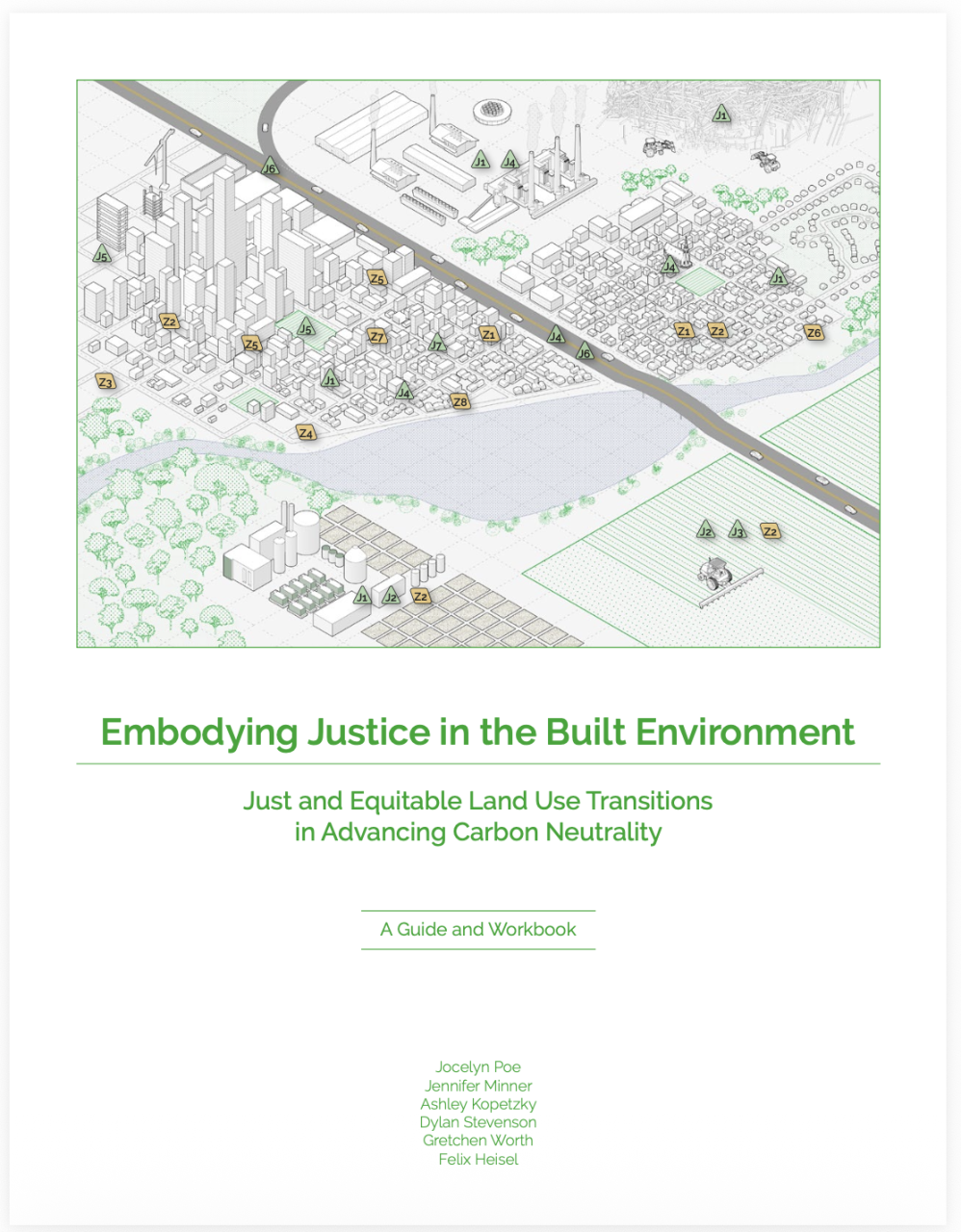
Embodying Justice in the Built Environment: Just and Equitable Land Use Transitions
Poe, Jocelyn, Jennifer Minner, Ashley Kopetzky, Dylan Stevenson, Gretchen Worth, and Felix Heisel, eds. Embodying Justice in the Built Environment: Just and Equitable Land Use Transitions in Advancing Carbon Neutrality. Ithaca, NY: Cornell University, 2025. https://doi.org/10.7298/m6e1-xx64
Embodying Justice in the Built Environment: Just and Equitable Land Use Transitions in Advancing Carbon Neutrality consists of a guide and workbook for local governments, community organizations, and other advocates seeking to center justice and equity as they work toward shifting land use and zoning to achieve carbon neutrality. This is the second guide in a series. The first guide is Embodying Justice in the Built Environment: Circularity in Practice.
This guide and workbook was created by researchers at Cornell University (in the Reparative Praxis Lab, Just Places Lab, and Circular Construction Lab), the University of Washington, and the Susan Christopherson Center for Community Planning. It was supported by the Carbon Neutral Cities Alliance (CNCA) and completed in partnership with Tracy Morgenstern, Simone Mangili, and members of the CNCA.
This guide and workbook supports community organizations in identifying opportunities for engagement and change, recognizing that creating just, equitable, and carbon-neutral cities requires action beyond local government alone. Designed to accompany CNCA’s City Policy Framework, it expands cities’ capacity to shape climate-conscious land use transitions rooted in justice and equity. Through practice stories and interactive targeted questions, this guide and workbook aims to prompt meaningful discussions among agencies, stakeholders, and communities.
Read more on the Carbon Neutral Cities Alliance website.
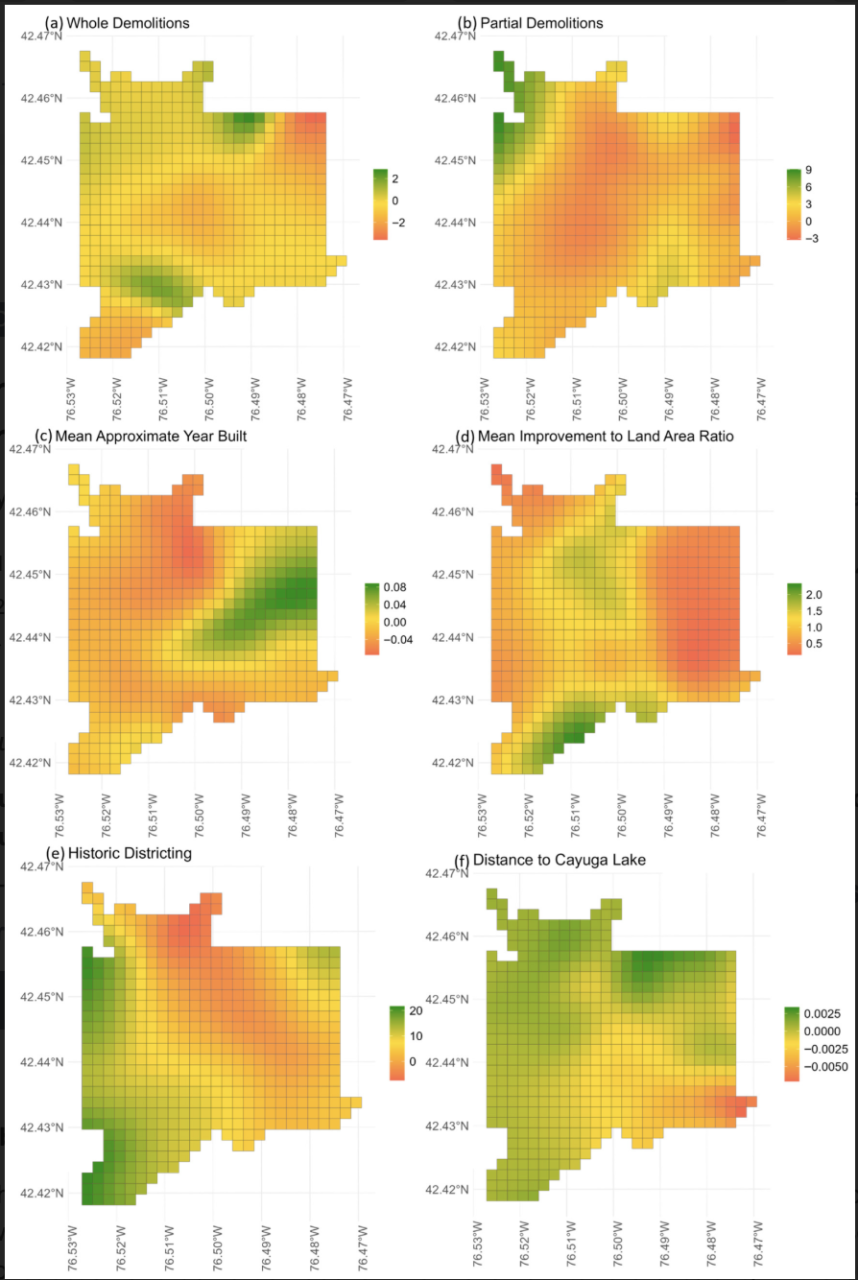
Incremental Urbanism and the Circular City: Analyzing Spatial Patterns in Permits, Land Use, and Heritage Regulations
Rangarajan, Shriya, Jennifer Minner, Yu Wang, and Felix Korbinian Heisel. 2025. "Incremental Urbanism and the Circular City: Analyzing Spatial Patterns in Permits, Land Use, and Heritage Regulations" Sustainability 17, no. 20: 9348. https://doi.org/10.3390/su17209348
Abstract
The construction industry is a major contributor to global resource consumption and waste. This sector extracts over two billion tons of raw materials each year and contributes over 30% of all solid waste generated annually through construction and demolition debris. The movement toward circularity in the built environment aims to replace linear processes of extraction and disposal by promoting policies favoring building preservation and adaptive reuse, as well as the salvage and reuse of building materials. Few North American cities have implemented explicit policies that incentivize circularity to decouple urban growth from resource consumption, and there remain substantial hurdles to adoption. Nonetheless, existing regulatory and planning tools, such as zoning codes and historic preservation policies, may already influence redevelopment in ways that could align with circularity. This article examines spatial patterns in these indirect pathways through a case study of a college town in New York State, assessing how commonly used local planning tools shape urban redevelopment trajectories. Using a three-stage spatial analysis protocol, including exploratory analysis, Geographically Weighted Regressions (GWRs), and Geographic Random Forest (GRF) modeling, the study evaluates the impact of zoning regulations and historic preservation designations on patterns of demolition, reinvestment, and incremental change in the building stock. National historic districts were strongly associated with more building adaptation permits indicating reinvestment in existing buildings. Mixed-use zoning was positively correlated with new construction, while special overlay districts and low-density zoning were mostly negatively correlated with concentrations of building adaptation permits. A key contribution of this paper is a replicable protocol for urban building stock analysis and insights into how land use policies can support or hinder incremental urban change in moves toward the circular city. Further, we provide recommendations for data management strategies in small cities that could help strengthen analysis-driven policies.
Constructing a Circular Economy in NYS: Deconstruction and Building Material Reuse
White Paper
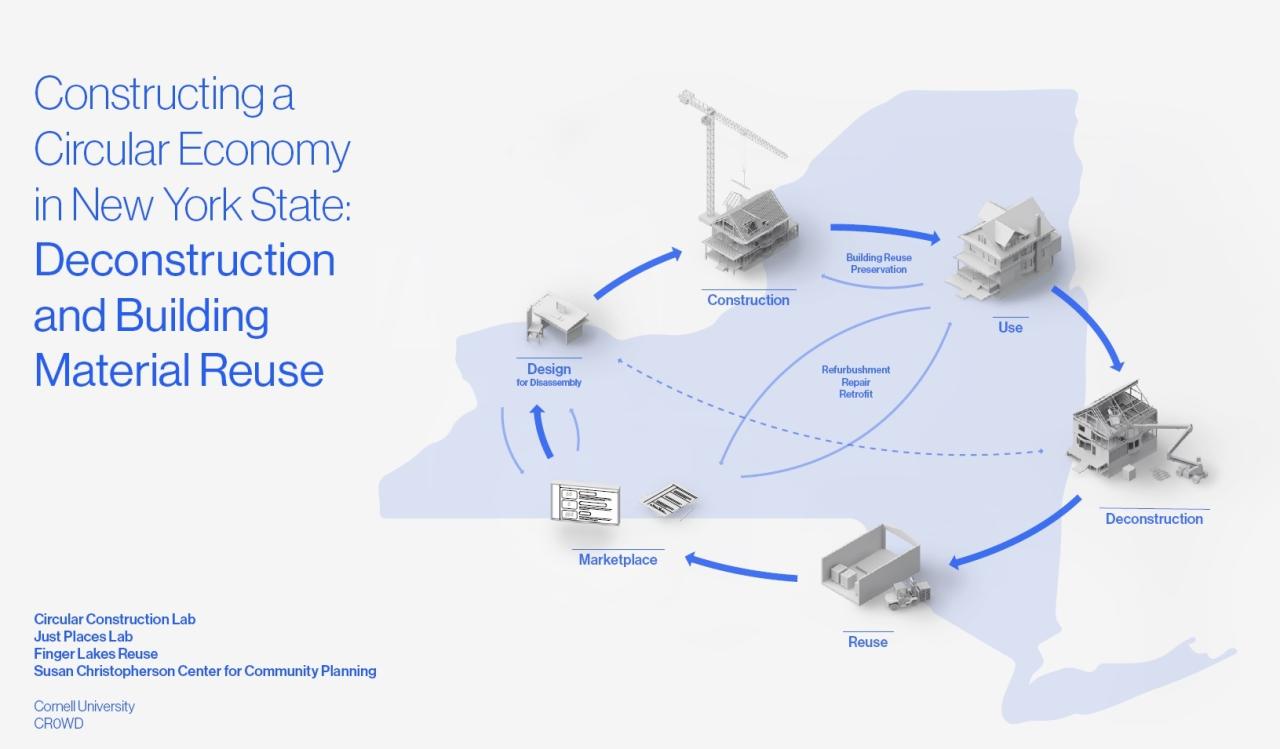
Constructing a Circular Economy in NYS: Deconstruction and Building Material Reuse is a new white paper authored by Cornell University researchers led by the Circular Construction Lab and Just Places Lab in collaboration with community organizations and industry experts within the New York State-based Circularity, Reuse, and Zero Waste Development (CR0WD) network. This research was generously supported by The 2030 Project, a Cornell University climate initiative housed within the Atkinson Center for Sustainability.
The white paper consists of an analysis of the current linear construction economy in New York State, an assessment of the economic, environmental, and social potential of deconstruction and reuse, and state-level policy and practice recommendations based on this assessment. The intent of this analysis is to aid policymakers, state agencies, and local governments in the development of a circular economy in New York State. Read more and download the report.
Embodying Justice in the Built Environment: Circularity in Practice
Guide and Workbook
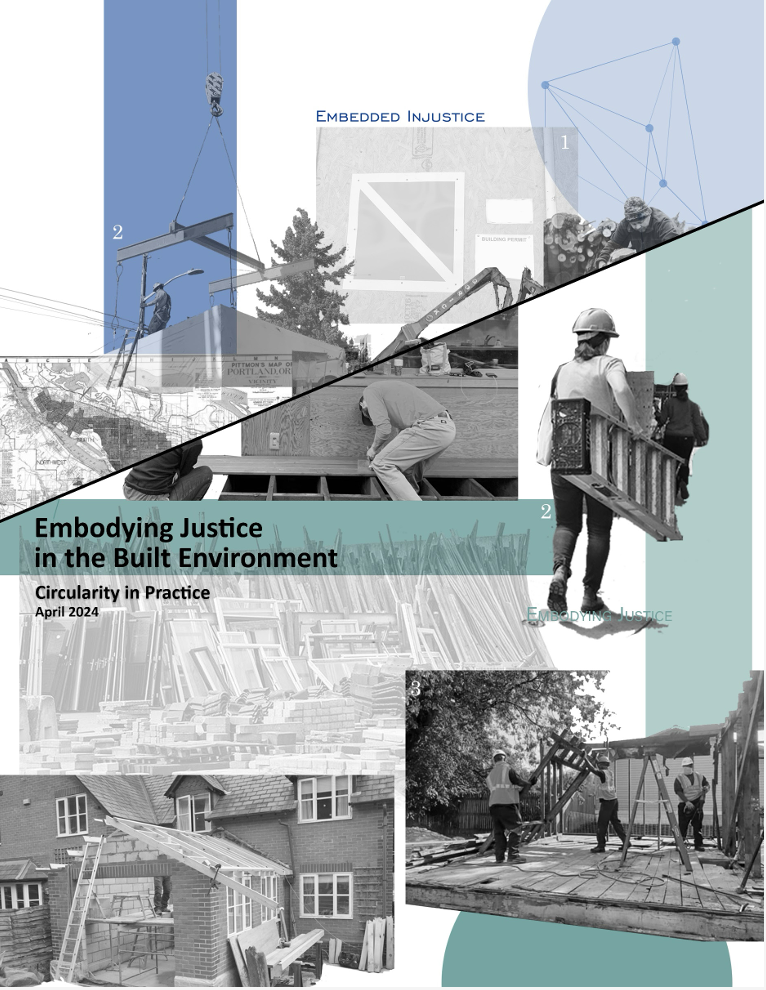
April 15, 2024: Embodying Justice in the Built Environment: Circularity in Practice is a guide and workbook for local governments and community organizations seeking to center justice and equity in their work toward building carbon neutral futures to address climate change. Unjust practices have shaped the built environment, from land dispossession to discriminatory planning, to harmful material extraction and toxic production processes, to wasteful construction and consumption practices. Current building processes have exacerbated injustices embedded in the built environment. This guide and workbook offers the Embodying Justice framework to support justice-oriented practices in the built environment and was developed with the belief that redressing injustices is integral to transitioning cities toward carbon neutrality.
This workbook was collaboratively authored by Jennifer Minner, Director of the Just Places Lab; Jocelyn Poe, Director of the Reparative Praxis Lab; Felix Heisel, Director of the Circular Construction Lab; Ash Kopetzky, Just Places Lab Researcher; Maya Porath, Just Places Lab Researcher; Gretchen Worth, Program Director of the Susan Christopherson Center for Community Planning. Creation of this guide and workbook was supported by the Carbon Neutral Cities Alliance (CNCA) and completed in partnership with the Susan Christopherson Center for Community Planning and Circularity, Reuse, and Zero Waste Development (CR0WD) network. Creation of the guide and workbook was supported by the Carbon Neutral Cities Alliance (CNCA) and completed in partnership with the Susan Christopherson Center for Community Planning and Circularity, Reuse, and Zero Waste Development (CR0WD) network.
Access guide and workbook:
Toward Building Sustainable Communities and Circular Economies
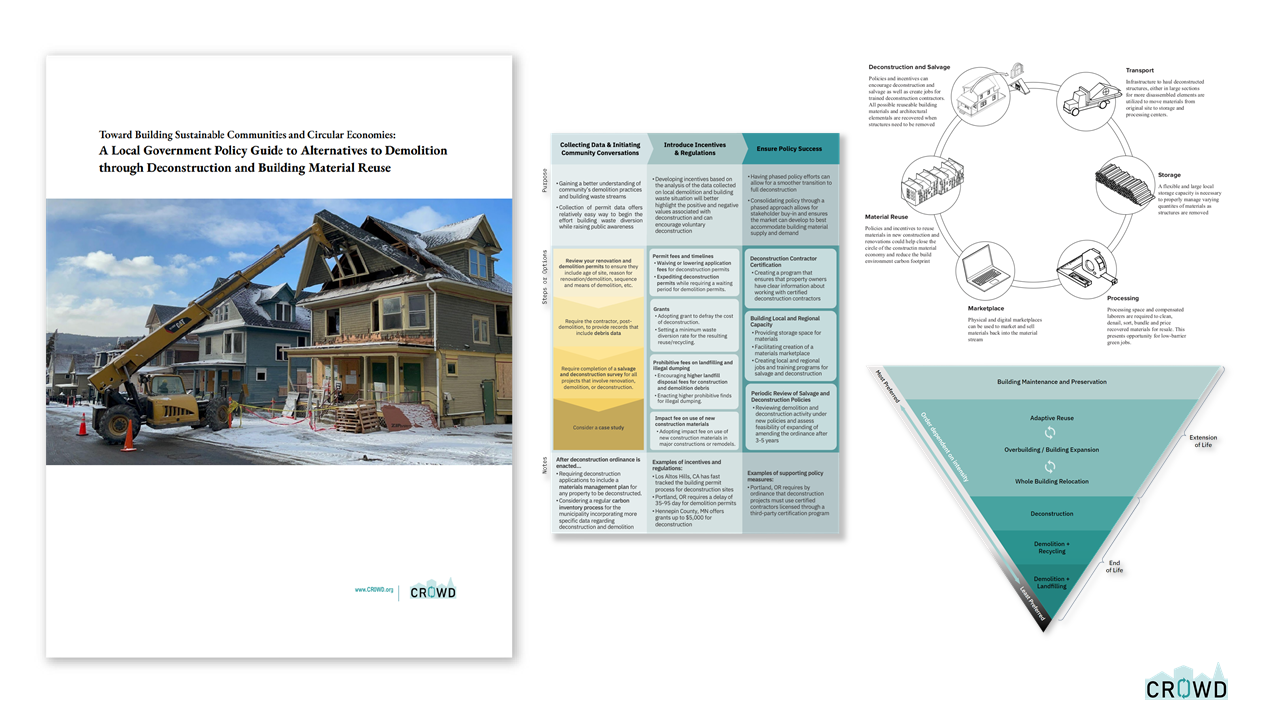
May 3, 2023 - Toward Building Sustainable Communities and Circular Economies: A Local Government Policy Guide to Alternatives to Demolition through Deconstruction and Building Material Reuse was collaboratively created by the Just Places Lab and CR0WD partners including the Cornell Circular Construction Lab, Historic Ithaca, Finger Lakes Reuse, the Susan Christopherson Center for Community Planning, and with the participation of City of Ithaca staff. The document includes a new conceptual diagram - a Building Reuse to Waste Hierarchy developed by Wyeth Augustine-Marceil with researchers in the Just Places Lab. Thanks to Courtney Bower, Brytton Burnside, and Kathy Lim who took the lead this semester on finishing this guide so that we can share it. Full credits are listed in the document, but important to note that numerous Cornell students were involved in research that informed this document.
Access file:
More about Just Places Lab and CR0WD
Do Land Banks Mean Progress Toward Socially Equitable Urban Development?
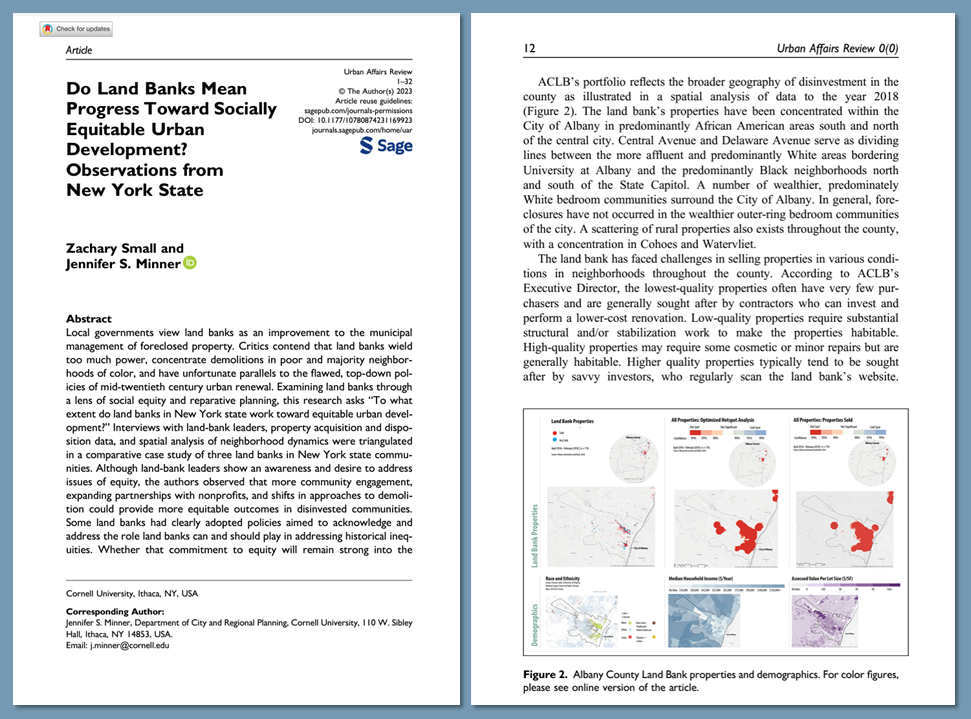
June 2023 -- Zachary Small, a collaborating researcher with the Just Places Lab and Cornell Master in Regional Planning alum, and director Jennifer Minner published an article in Urban Affairs Review investigating how land banks in New York State work toward socially equitable development. This research draws on interviews with leaders of land banks in New York state. The article includes case studies of three New York State land banks: the Albany County Land Bank, the Newburgh Community Land Bank, and the Buffalo Erie Niagara Land Improvement Company. To understand the racial, socioeconomic and built environment characteristics of the communities, a comparative spatial analysis of land bank properties was performed using data provided by the land banks, American Community Survey data, and publicly available county and city property data. Land bank staff were interviewed pre-pandemic and then contacted again to understand COVID-19 era conditions and shifts in land bank policies.
Small and Minner call for land banks to take a reparative approach in addressing vacant and abandoned properties. Read more on the Urban Affairs Review blog.
Building social legacies at former and future Expo sites: the case for equity
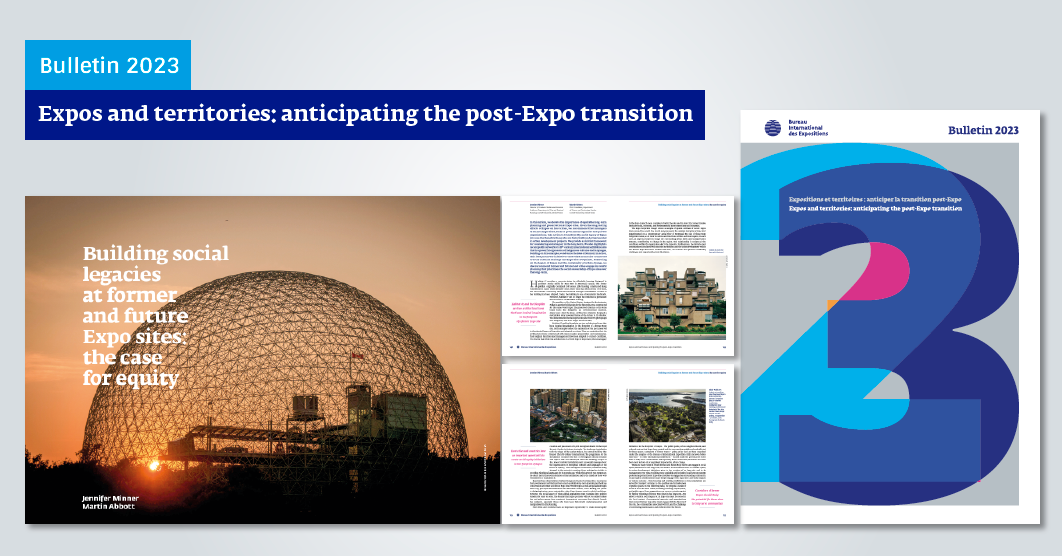
April 27, 2023 - "Building social legacies at former and future Expo sites: the case for equity," by Jennifer Minner and Martin Abbott, was recently published in the 2023 Bulletin of the Bureau International des Expositions (BIE).
In this article, we elevate the importance of equitable long-term planning and preservation at Expo sites. Given the long-lasting effects of Expos on host cities, we recommend that managers of former Expo sites, such as government agencies and private organizations, take action to transform the social legacy of Expos into one that benefits those who are historically underrepresented in urban development projects. We provide an initial framework for considering social legacy in the long term. We also highlight a recent public artwork at a 19th century international exhibition site that is a powerful expression of Indigenous cultures and languages. Building on this example, we advance the idea of Memory in Action. This idea promotes initiatives that build memories connected to local cultural heritage and Expo site footprints. Reflecting on the legacy of Expos and the complexity of urban change, we also recommend former and future host cities engage in careful planning that prioritize the social stewardship of Expo sites over the long-term.
More information and the link to download the entire 2023 BIE Bulletin is available here.
Chapters in Circular Construction and Circular Economy
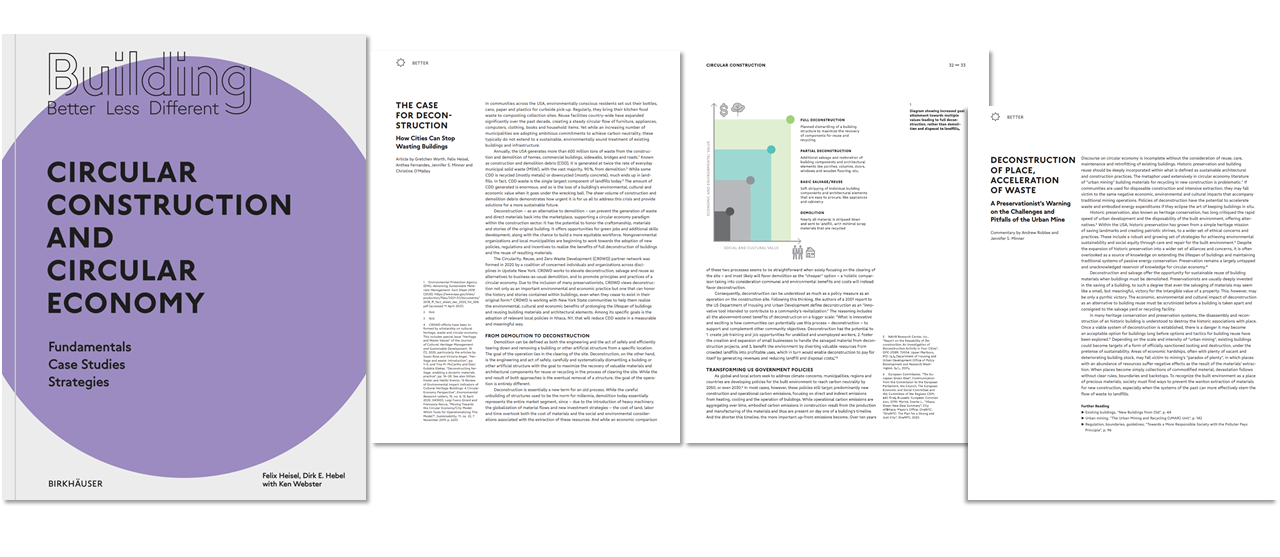
Just Places Lab director Jennifer Minner and researcher Anthea Fernandes were co-authors with additional Circularity, Reuse and Zero Waste Development (CR0WD) network partners to two chapters in the 2022 book Circular Construction and Circular Economy edited by Felix Heisel and Dirk E. Hebel, in collaboration with Ken Webster. Read more about the book. The two chapters represent both the promise of deconstruction in building a more circular economy. In the commentary "Deconstruction of Place, Acceleration of Waste" Andrew Roblee and Jennifer Minner argue that preservation must not be overlooked, a strategy for retaining embodied carbon that also retains a sense of place and history.
Global city patterns in the wake of World Expos: A typology and framework for equitable urban development post mega-event
by Jennifer Minner, Grace Yixian Zhou, and Brian Toy
Published in Land Use Policy journal.
International exhibitions, also known as world's fairs or international expos, are important examples of large-scale mega-events. Regulated and promoted by the Bureau of International Expositions, world and specialized expos are purported to aid in the achievement of urban development goals for host cities and nations. Scholars have focused analyses on the social and economic impacts of staging mega-events and in the immediate years after events. In this article, the authors consider the spatial and land use aspects of expo sites, developing a post-expo typology to aid in in-depth and comparative analysis of spatial patterns across sites and years after the mega-event. The authors then present a framework for equitable urban development, to consider the equity dimension of sustainability at former mega-event sites. The urban development typology is then considered with the equitable urban development framework, to propose interventions that are specific to particular expo types. The article links consideration of spatial land use patterns and expo legacies long after the first wave of urban development associated with staging an expo has passed.

More than repairing cracks in the façade: Building systemic change in times of crisis
This article was recently published in Erica Avrami's edited book on Preservation, Sustainability, and Equity. The entire book is freely available to read online, as well as for sale in print form.
I wrote this chapter in 2020 to readers of the near future. The chapter features a series of questions posed to the many actors who comprise preservation as it exists today about areas of progress. Are we contributing to equitable opportunities through support and expansion of skilled green jobs? Are we helping to build a more robust and creative imagination and awareness of the built environment and inspired action toward addressing crises of public health, housing, economy, and climate change? The chapter includes policy considerations and proposals that could contribute to important transformations both within preservation and within a larger network of allied actors. I discuss a series of questions or ‘problem sets’. These arrays of evaluation, written to policymakers, professionals, and the public and are organized into these domains of action: Green and Equitable Recovery for Climate Action; Re-building Alliances and Equity Preservation; Conservation, Circular Cities, and the Paradox of Thrift; Public Imagination, Visibility, and Remembrance; Transformation or Maintenance of the Status Quo. My hope is that this chapter will soon become antiquated, as policymakers and professionals, scholars and students, are able to provide robust answers to these queries. May the crises of today become a period of distant memories of the obstacles eventually overcome – a time that future generations pause to learn from.
A Pattern Assemblage: Art, Craft, and Conservation
The Northland Pattern Wall: City of Past and Future Craft is an assemblage artwork created by artist and architecture professor Dennis Maher with co-instructors and students of the Society for the Advancement of Construction Related Arts (SACRA) program. SACRA is an arts-based vocational training program providing construction skills training to individuals in need. It is based at Assembly House 150, an artist-led experiential learning center in Buffalo, New York. This article employs qualitative methods inspired by the hermeneutic spiral to examine the Northland Pattern Wall, SACRA, and Assembly House 150. This article highlights takeaways for heritage conservation, as well as allied professions, about the relevance of building trades and creative practices that help to shape and conserve the built environment. The story behind the Northland Pattern Wall is used as an opportunity to reflect on the potential to build stronger alliances between professionals, tradespersons, and artists in designing creatively out of the patterns of the past to build a more sustainable and equitable future city.
Preservation that Builds Equity, Art that Constructs Just Places
The built environment in US cities displays uneven geographies and patterns of spatial exclusion. Preservation, as a profession that cares for places and communities should help to redress these inequities. Likewise, socially engaged art and creative practices can act as catalysts for transformative change. This article describes three community engaged courses in which students drew connections between concepts of equitable preservation, socially engaged art, and the just city. The Equity Preservation Workshop focused on creating a toolkit of policies for preservation alliances with community development. In Just Places? Community Preservation, Art and Equity, students investigated how the arts can ignite historical consciousness and employ creative practices that repair, adapt, and preserve places. Art, Preservation, and the Just City generated ideas for creatively engaging youth with place, identities, and the built environment. Students conducted research with preservation organizations including the National Trust for Historic Preserva tion and Preservation Buffalo Niagara; a creative-placemaking program of Enterprise Community Partners; and Assembly House 150, a nonprofit in Buffalo that transforms lives and the built environment through art, design, and construction. This article describes these field investigations into the layers of intersection, interaction, and possibility between preservation, art, and social equity.
DOI: 10.5749/futuante.17.2.0133


